|
|
|

Aviation Safety Research
"Technical Research in the
field of Aeronautics"
Resources for Flight Operations
|
|
|
Airman Certification Standards MP3
Airman Certification Standards (FAA Website Link)
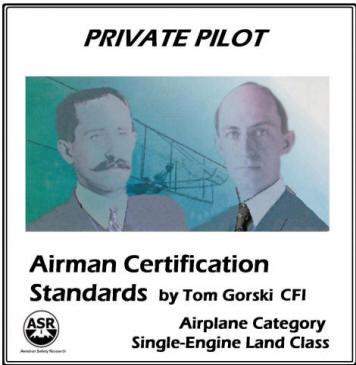
FAA-S-ACS-6
July 2016
Aeronautical
knowledge, flight proficiency, and risk management
standards for
certification in the airplane category, single-engine
land class.
This album was made available on-line through music distributors,
and now
available by selecting the links below.
Play Entire Private Pilot ACS Album 1:58
|
|
In 2017 the FAA replaced the PTS for the Private Pilot Airplane certificate and
the Instrument-Airplane rating, with the ACS.
ACS provides a single-source set of standards for both the knowledge exam
and the practical test.
It clearly tells applicants, instructors, and evaluators what an
airman must KNOW, CONSIDER, and DO to pass the
knowledge test and the practical test for an airman certificate or rating.
It shows how the required knowledge, risk management, and skill elements for
each Area of Operation/Task are connected.
It defines expectations and behaviors for risk management and connects them
to specific Tasks.
It puts the “special emphasis” items from the PTS in the right context.
The ACS enhances safety by making tests relevant to actual operations and
contributes to standardization. |
|
01_Introduction
02_Pilot Qualifications
03_Airworthiness Requirements
04_Weather Information
05_Cross-Country Flight Planning
06_National Airspace System
07_Performance and Limitations
08_Operation of Systems
09_Human Factors
10_Preflight Assessment
11_Cockpit Management
12_Engine Starting
13_Taxiing
14_Before Takeoff Check
15_Communications and Light Gun Signals
16_Traffic Patterns
17_Normal Takeoff and Climb
18_Normal Approach and Landing
19_Soft Field Takeoff and Climb
20_Soft-Field Approach and Landing
21_Short-Field Takeoff and Maximum Performance Climb
22_Short-Field Approach and Landing
23_Forward Slip to a Landing
24_Go-Around Rejected Landing
25_Steep Turns
26_Ground reference
Maneuvers
27_Pilotage and Dead Reckoning
28_Navigation Systems and Radar Services
29_Diversion
30_Lost Procedures
31_Maneuvering During Slow Flight
32_Power Off Stalls
33_Power On Stalls
34_Spin Awareness
35_Straight-and-Level Flight
36_Constant Airspeed Climbs
37_Constant Airspeed Descents
38_Recovery from Unusual Flight Attitudes
39_Turns to Headings
40_Emergency Descent
41_Emergency Approach and Landing (Simulated)
42_Radio Communications, Navigation Systems,
Facilities, and Radar Services
43_Systems and Equipment Malfunction
44_Emergency Equipment and Survival Gear
45_Night Preparation
46_After Landing, Parking and Securing
47_Conclusion
|
|
Instrument Rating Airman Certification Standards MP3
Airman Certification Standards (FAA Website Link)
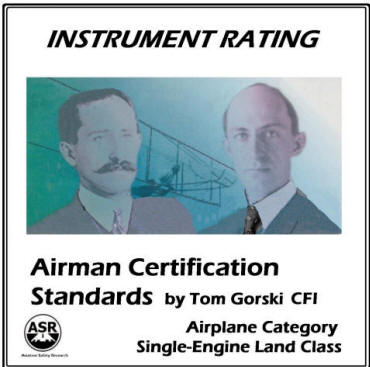
FAA-S-ACS-8 July 2016
Aeronautical
knowledge, flight proficiency, and
|risk management standards for Instrument
Rating
certification in the airplane category, single-engine land class.
This album is now available by selecting the links below.
Play Entire Instrument Rating ACS Album 42:37
|
|
|
01_Introduction
02_Pilot Qualifications
03_Weather Information
04_Cross-Country Flight Planning
05_Aircraft Systems Related to IFR Operations
06_Aircraft Flight Instruments and Navigation
Equipment
07_Instrument and Equipment Cockpit Check
08_Compliance with Air Traffic Control
Clearances
09_Holding Procedures
10_Instrument Flight
11_Recovery From Unusual Flight Attitudes
12_Intercepting and Tracking Navigational
Systems and DME Arcs
13_Departure, En route and Arrival Operations
14_Nonprecision Approach
15_Precision Approach
16_Missed Approach
17_Circling Approach
18_Landing from an Instrument Approach
19_Loss of Communications
20_Approach with Loss of Primary Flight
Instrument Indicators
21_Checking Instruments and Equipment
22_Conclusion
|
|
1985 PTS ALBUM NOTES
In 1985 while teaching flying in New Jersey, I discovered the new
standard of the industry
for the conduct of pilot training, testing and evaluation. The new
standard was called the
Practical Test Standards or PTS.
PTS was a breakthrough, because it established standards
for practical tests conducted in airplanes.
From this point on, examiners were required to conduct practical tests in
compliance with these standards.
I found the PTS extremely helpful in preparing my students
for the practical test.
To help prepare my students, I transcribed text of the first version
of the PTS into a readable narrative format, and recorded audio
cassettes of the material.
The transcript served as a template for
the administration of my flight training lessons, and enabled my
learning and understanding of the task details. |
|
|
|
|
|
|
|
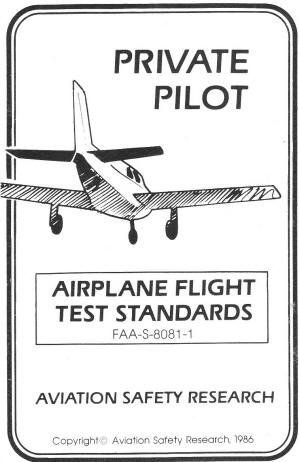 |
|
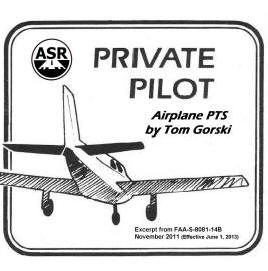
FAA-S-8081-14B
With Changes
1-6 (2012)
I remade the PTS in 2012 with the latest changes prior to the release of
ACS. These albums were available through music distribution sources.
8081-14B with changes 1-6 included Single Pilot Resource Management, and
revised areas of emphasis. |
|
FAA-S-8081-1 (1985)
My first PTS was a cassette tape narrating the 47 tasks
which may be required to be performed during the Private Pilot Checkride in
Single-engine aircraft with fixed-pitch propellers and non-retractable
landing gear.
Tasks in the 12 Areas of Pilot Operation are spoken in logical order with
the first three letters of each task in Morse Code for punctuation. Tasks
are discussed in detail and included what should be done, the conditions
under which the task is to be performed, and the minimum acceptable
standards for successful completion. Areas upon which the evaluator will
place emphasis were included.
Cassette Cover Graphics by Peter Bonneau
|
|
|
|
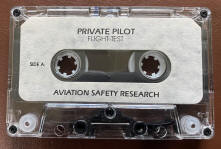
Private Pilot Airplane Flight On Tape
Cassettes were sold in 1989 through ads placed in magazines, and
contained clear shells and boxes.
AREAS OF OPERATION
Preflight Preparation
Ground Operations
Airport and Traffic
Pattern Operations
Takeoffs and Climbs
Cross-Country Flying
Flight by Reference to Instruments
Flight at Critically Slow Airspeeds
Turn Maneuvers
Flight Maneuvering by Reference to Ground Objects
Night Flight Operations
Approaches and Landings
|

SELECT CASSETTE
TO LISTEN |
|
|
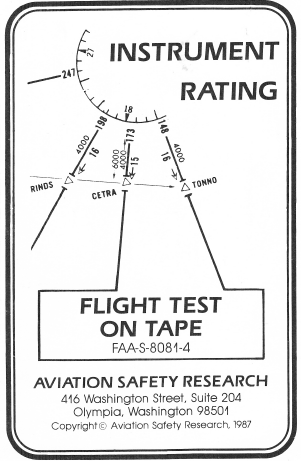
FAA-S-8081-4 (1987)
My second cassette was the Instrument Rating PTS for airplanes
and helicopters. I called it Flight Test on Tape. I found this tape useful as
a review of the tasks required during the conduct of IFR Check rides, as a
review of the tolerances and evaluation criteria for each task.
Cassette Graphics by Tom Gorski |
|
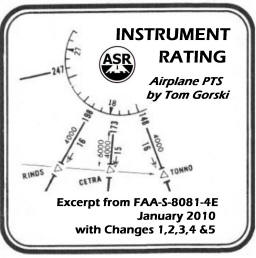
FAA-S-8081-4E
With Changes 1-5
(2010)
This was a revision of my second audio cassette
which was release in 1986. 8081-14E with Changes 1-5 included Single Pilot Resource Management, and
revised areas of emphasis.
|
|

Instrument Rating Flight Test on Tape
Cassettes were sold in 1989 through ads placed in magazines, and
contained clear shells and boxes.
|

SELECT CASSETTE
TO LISTEN |
|
|
AREAS OF OPERATION
Ground Phase
Air Traffic Control
Clearances &
Procedures
Flight By Reference
To Instruments
Navigation Aids
No-Gyro Procedures
Instrument Approach Procedures
Instrument Flight In A Multi-Engine Aircraft |
|
|
|
Before the PTS, we utilized Flight Test Guides. These Advisory
Circulars were bound, printed and sold by the Government Printing Office,
and available at FBO's for purchase. They cost less than a dollar at
the time.
With Flight Test Guides, evaluators could pick and choose which procedures and/or maneuvers to evaluate.
|
|
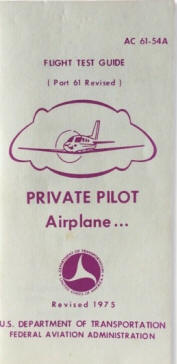 The
Private Pilot Flight Test Guide (1975) had 10 Areas of Operations: The
Private Pilot Flight Test Guide (1975) had 10 Areas of Operations:
Preflight Operations
Airport and Traffic Pattern Operations;
Flight Maneuvering by Reference to Ground Objects;
Flight at Critically Slow Airspeeds;
Takeoffs and Landings;
Maneuvering by Reference to Instruments;
Cross-Country Flying;
Max Performance Takeoffs and Landings;
Night Flying-Night VFR Navigation;
and
Emergency Operations. Flight Test
Guides were booklets
containing Areas of Knowledge, Objectives, Descriptions of Procedures, and
Acceptable Performance Guidelines. |
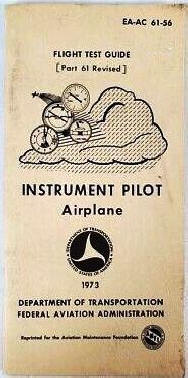
|
|
|
|
|
|
|
|
|
I made these
recordings to help remember relevant
details and subtexts upon which to build my instructional scenarios.
Learning the Standards is as important for the CFI as regulations and procedures
are for the certificated pilot.
I hope you
enjoy listening to these
programs. Thank
You!
-Tom Gorski 2267082CFI |
 |
|
|
|
Produced by
ASR
|










 The
Private Pilot Flight Test Guide (1975) had 10 Areas of Operations:
The
Private Pilot Flight Test Guide (1975) had 10 Areas of Operations: